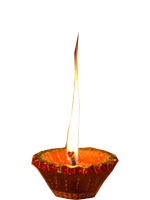 History Of Lighting Lamp
History Of Lighting Lamp
Light and darkness the contrasting features symbolize two different factors namely the former indicates knowledge and the latter denotes ignorance. Light is always compared to Lord for he is the source of knowledge and also known as "Knowledge Principle," or Chaitanya, who restores life or vigor and the spiritual illuminator of our knowledge. When light is brought into darkness it has the power of removing the darkness completely. Light symbolizes knowledge and Isana is the origin of knowledge.
 Light Removes Away Darkness
Light Removes Away Darkness
-Just like light removing away darkness, knowledge is said to remove the ignorance in a person. Also knowledge is considered to everlasting wealth of a person which will help the individual to accomplish all his or her wishes and achievement. Thus light is lit through a lamp in regard to knowledge as the greatest of all forms of wealth. An oil lamp is lit to bow down to knowledge as the greatest of all forms. To light a lamp we mainly require oil or ghee and cotton wicks where the oil added to the lamp signifies our vices and the cotton wick denotes the ego of an individual. Thus with this comparison when the lamp is lit by spiritual knowledge the vices are said to be drained out and once it is exhausted automatically the ego of a person finds its way out. The flame of a lamp never burns downwards and it only burns in upward direction indicating that one should acquire knowledge in such a way that it takes us only towards better perfection. The lamp which symbolizes Tej, the Absolute fire principle has its own special status in Sanatan Vaidik Hindu Dharma.
 Darkness to Light passes on the Message of Peace
Darkness to Light passes on the Message of Peace
-Deepajyothi parabrahma
-Deepa sarva tamopahaha
-Deepena saadhyate saram
-Sandhyaa deepo namostute
 Women usually light lamps
Women usually light lamps

 Note of this is also made in Lalitha Sahasranamam which says,
Note of this is also made in Lalitha Sahasranamam which says,
"Om Suvasinyay namah
Om Suvasin archanapreethayay namah".
 In Most Of The Hindu Homes We Can Witness A Lit Lamp in Front of the Lord
In Most Of The Hindu Homes We Can Witness A Lit Lamp in Front of the Lord

There are group of people who argue by comparing the tube light or bulb in comparison to that of the diyas or the lamp, for they fail to understand that the oil lamp lighted using wicks have much more further spiritual significance like our vaasanas or negative tendencies and the wick, the ego. Just like the flame of the lamp one should develop knowledge which helps us in removing our lofty ideas and incomprehension. Lighting of lamp has other significances like it is a part of Bhutaaradhana or element worship.
 It is a Traditional Practice in India to Light a Lamp
It is a Traditional Practice in India to Light a Lamp
-When we light a lamp we simultaneously get to pay regards to other Gods like as we light a lamp for Agni, place water for Jala, we place incense stick smoke for vayu, sandal paste, Bhasma, vermilion for Prithvi and deep meditative prayer for Akasha.It is a traditional practice in India to light a lamp before starting any propitious ceremony or rituals. When we light a lamp the divine good will of the almighty is spread throughout the house thereby taking away the darkness, grief, sorrow and unhappiness. Gods first and foremost appearance is in the form of Light which we call as 'Divya Jyotir' or "Divine Light". By lighting the lamp we are said to kill the enemies of our intellect namely Kama, krodha, lobha, moha, mada and matsarya.Off late we can even witness men lighting lamps especially in temples and doing various other associated activities like donating oil to the temple or donating a lamp to the temple. Lighting lamps in the temples illuminates our life. When lamps are lighted in our homes every evening and we pray by reciting a few slokas, it will make our lives sparkle like the lamp.
 Diwali Lights
Diwali Lights

 Legens about Tulasi which comes across during the Churning of the milky ocean
Legens about Tulasi which comes across during the Churning of the milky ocean
-Usually Diwali is celebrated on the new moon day when there is total darkness everywhere. Evil spirits are generally said to be active during darkness. So, lamps are lit in every corner of the house to weaken these evil forces. The lights of Deepavali outside every door signify that the inner spiritual light of an individual must reflect outside too. With one lamp lighted hundreds of other lamps can also be lighted without affecting its own light which is signifying the fact of unity among each other.Lighting of lamps facing different directions has various significances - when a lamp is lighted facing the North, it means we wish for success in all that we do and also this is the most preferred direction to light a lamp. Lamps facing the eastern direction indicate good health and peace of mind. If we wish freedom from loans and success over enemies then the suitable direction to light the lamp is facing east. A lamp is never lit facing the south direction for it is considered to be inauspicious.
 The House in Which Five Wicks or the Panchamkukha Deepam
The House in Which Five Wicks or the Panchamkukha Deepam
-Similarly the number of cotton wicks used also signifies various theories like that a single wick is used to pray for normal welfare and this kind of deepam is known as Eka Mukha Deepam. Dwimukha deepam or the lamps with double wicks are said to bring about consonance and peace among friends and family. One is blessed with progeny when three wicks or the Trimukha Deepam is used. The Chathurmukha deepam with four wicks is said to bring all-round prosperity and good food. The house in which five wicks or the Panchamkukha deepam is used is showered with akhanda aishwaryam and wealth. The five faces of the lamps are said to indicate the five notable qualities that a woman of the house is supposed to have namely affection, intelligence, resoluteness, patience and caution.The place where the oil is poured denotes the mind of the women of the house, thus when the lamp is lighted all the five adorable qualities of the woman becomes distinct. The Shanmukha deepam with six wicks blesses with Knowledge and renunciation.Each portion of the lamp symbolizes the different Gods like the bottom portion of the lamp indicates the lotus seat of Lord Brahma, the middle portion of the lamp denotes Lord Venkateswara. Rudran is represented in the portion where oil or ghee is filled. The portion where wick settles signifies Lord Maheswara and the portion where the wick ends is Lord Sadashivam.One of the main guideline followed while doing aarthi with the lamp is that it is supposed to be rotated in the form of OM from the foot till the head at least thrice and always smear the lamp with vermillion and sandal powder.



 History Of Lighting Lampe
History Of Lighting Lampe
























































